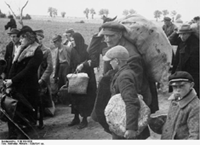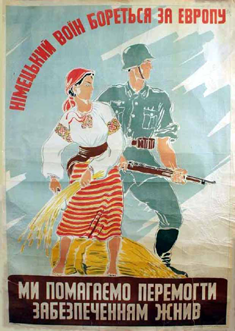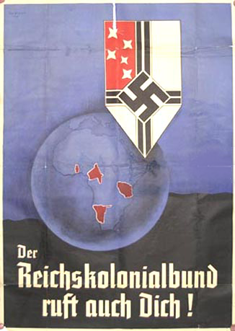Esther M. Zimmer Lederberg
Not a Supporter of Eugenics
Reichsgau Wartheland
(German Ost)
Germany's colonial expansion in the late nineteenth century encompassed
not only Africa and the South Pacific, but Eastern Europe.
1, 2, 3 German settlements were
created in Prussia in the late 1880s; Germany joined forces with those
involved in trying to create an "independent Ukraine" in 1918; and in
1939 Germany established the Reichsgau Wartheland
in areas that roughly corresponded to Poland, Lithuania, Latvia and the Ukraine.
(At various times historically parts of the Ukraine had been part of Poland,
part of Lithuania, part of the Austro-Hungarian Empire, etc. Thus, there
was already a precedent for the creation of a 'new' colony in these locations.)
Otto von Bismarck's Prussian Settlement Commission: 1886
In 1886, Otto von Bismarck established the ''Koniglich Preussische
Ansiedlungskommission'' Royal Prussian Colonization Commission
in the Prussian partition of Poland. In this decade thousands of
Poles were evicted into Russia. 4
It also led to the colonization campaign in the East. The Commission was
financed by 100 million marks, used to purchase large Polish land estates
from members of the Polish szlachta (gentry), which were then
broken down into many small parcels of farm land. These parcels were
intended to subsidize German peasants in the Polish East.
5, 6, 7
The "Verein Forderung des Deutschthums in den Ostmarken"
(the "German Eastern Marches Society") was establised in 1894,
renamed the "Ostmarkenverein" (the "Eastern Marches Society")
or the "HKT" or "Haktisten" after 1899. The "HKT" abbreviated "Hansemann,
Hermann; Kennemann; and Tiedmann, Heinrich von. This was a propaganda
effort to settle German peasants in Poland. 8
The basis of the propaganda was a focus on the healthy German volk
(peasants) as opposed to the Polish peasants, who were referred to
derrogatorily as the degenerate "Polacks". (The idea of "degeneracy"
here is that the "Polacks" (and Jews) were viewed as filthy, backward,
criminal or lazy subhumans who lived in Eastern Europe.) The German
"type" of peasant who was intended to populate this new colony was
envisaged to be a hard worker, likely to be found in a frontier
setting. Appeals were made to the kind of frontiersman found in the U.S.
9 By 1914, the Eastern Marches Society
demanded forced population movements and relocation of large groups of
people, these proposals are pointed out as part of prehistory of genocidal
measures employed by Nazism; similar population policies were envisioned
in German Southwest Africa. 10
The image of the "degenerates" living in Poland were often of Polish
women referred to as examples of "Slavic blackness". References were
made to "black Kascha" or "black Bronislaw". "Blackness" referred to
black eye color, black clothes, Gypsy-like appearance, dark skin,
loose hair style (feminine seductiveness) vs the German "whiteness":
blue eye color, blond or flaxen hair color, light skin, braided
(contained) hair wrapped into a bun. This image of "seductiveness"
was used because it was feared that the German population would be
sexually diluted by miscegenation with the Polish natives. (This was
the same problem that led to legislation banning intermarriage between
Germans and indigenous people in the German colonies.)
11, 12, 13
The fear extended beyond possible dilution of German racial purity,
into dilution of German political power: mixed-raced children of
Germans and Poles would inherit citizenship from their German parent,
as opposed to the Poles being expelled from this idealic German colony.
(This, too, later occurred in reality in the German South West African
colony circa 1908.) 14, 15
The image of German frontiersman purity were based on a German
environment that prized purity, cleanliness and organization, and
well-managed farmsteads; as opposed to the "Polack" farmsteads that
were viewed as being filthy, with dirty children in dirty, torn
clothing, beset by pestilence, drunkeness, backwardness, laziness
and criminality. Rural farmsteads were targeted, not the cities
(which were viewed as places for degenerates such as Jews). This
view of the "Polack" was referred to as "Polnische Wirtschaft" or
the environment of a Polish Tavern. Popular literature ("Ostmarkenroman")
based on this discription was well-known to Germans at this time.
16
German African Colonial Experience
Before World War I, Paul Rohrbach was the Settlements Commissioner
in German South West Africa. Concerned with miscegenation, he is quoted
as follows:
"In order to secure the peaceful White settlement against the bad,
culturally inept and predatory native tribe, it is possible that
its actual eradication may become necessary under certain conditions."
17
.
See
http://www.esthermlederberg.com/Eugenics (Altenburg)/Shark Island Extermination Camp.html
Germans Help Establish an Independent Ukraine
Independently of what was happening in German South West Africa,
in 1918 the Germans had invaded the Ukraine while people like
Symon Petliura and Anton Denikin (infamous anti-Semites) were also
trying to establish an independent Ukraine. Rohrbach worked with
Field Marshal Hermann von Eichhorn, commander of the German forces
in the Ukraine, to install General Pavel Petrovitch Skoropadski as
"Hetmann" of the Ukraine. 18
Nazi Ost (East) Colonial Expansion
During the Third Reich, German colonists from German East Africa
and other former German African colonies were moved into Polish
land "annexed" in 1939. 19
This new settlement area was called the Reichsgau Wartheland.
Paul Rohrbach focused his worked upon this, then others put his
ideas into action. (Generalplan Ost and expulsion of Poles,
Gestapo-NKVD Conferences.)
The practices of forced labour and exploitive population policies
of the German Empire were used in more extreme forms by Nazis.
In 1942/1943 Nazi economists established the Togo Ost Society
in the Ukraine, 20 bringing along
agricultural models from Africa to Eastern Europe. Additionally German
Africans were brought from eastern Africa to Warthegau.
21 As model pioneers they were to
inspire European Germans to settle in Poland. 22
"... Hitler, Darre, and other Nazi ideologues played down
overseas colonialism and concentrated instead on contiguous
German settlements in Eastern Europe and especially Ukraine
where the Aryan 'soldier-peasant' tilled the soil with a
weapon at his side, ready to defend the farm from the 'Asian
hordes.' As for the Ukranians whom the Nazis pejoratively
branded 'Negroes,' Hitler remarked that the Germans would
supply them 'with scarves, glass beads and everything that
colonial people like.'" 23
The movement of German colonists displaced Poles (the indigenous
population), Jews and Gypsies, who were considered inferior.
Generalplan OST
Friedrich Ratzel developed the idea (expressed in his two-volume work,
Anthropogeographie) of lebensraum. "Lebensraum" was interpreted
as the racial basis for nationalist views of geographic expansion. Ratzel's
views were combined with Social Darwinism. Nationalism, geographic expansion,
and Social Darwinism laid the foundation for the destruction of "inferior
races" by "superior races" such as the Aryans, and provided a basis whereby
this destruction could be viewed as the moral expression of Nature. This
view was promptly employed by Germany in its colonies, justifying genocide
(for example, in Deutsche Südwestafrika and Deutsche Ostafrika
during the Second Reich).
Ratzel's ideas were elaborated during the Third Reich to support the creation
of lebensraum in Wartheland. This elaboration was based on the
experience of military personnel such as Paul Rohrbach, who had served in the
African colonies. Adolf Hitler was highly influenced by these views, and had
no problem viewing the people of Poland, Ukraine (Lithuania, Latvia, Ruthenia)
and Russia as effectively being "negroes" who could be exterminated and
replaced by Germans.24, 25, 26
"Although no copies of either the first or the second GPO survive, we do have
a detailed analysis of it [the second], dated April 22, 1942, by Dr. Erhard
Wetzel, the expert on race issues in the Reichministry for Occupied Eastern
Areas." It is as follows:
-
31 million people to be resettled from the occupied eastern areas
-
10 million Germans or "Germanic people" to be resettled in the East after
the war, "to replace most of the native population from the area between
Russia and Germany, estimated at about 45 million people, of whom 31 million
were declared to be 'racially undesirable' and who were to be sent to western
Siberia."
-
"About 14 million of the conquered people were to remain, but only to be
used as slaves."
-
"Those deported would have included 100 percent of all the Jews, about
80 to 85 percent of the Poles, 75 percent of the White Russians, and
64 percent of the west Ukranian population."
"Given these percentages, it would have been impossible for any of these
nations to survive as cultures or nations in any meaningful sense, so
that these plans explicitly accept that all four of these nations would
for all intents and purposes cease to exist. These plans in effect, therefore,
called for nothing less than serial genocide."27, 28, 29
1
Robert L. Nelson Palgrave, "Germans, Poland, and colonial expansion to
the East: 1850 through the present", Macmillan, 2009
.
"This incisive collection probes the history of colonialism within
Europe and posits that Eastern Europe was in fact Germany’s true
'colonial' empire. Through a series of interdisciplinary essays ranging
from 1850 to the European Union of today, this collection explores the
idea that Germany’s relationship with Poland and Eastern Europe had many
similarities to the practice of 'overseas' colonialism. As the contributing
scholars aptly demonstrate, the history of Germany’s relationship with
Poland contains all the trappings of the classic colonial encounter, from
its structures of power and control, racism and cultural chauvinism, to the
implementation of wholesale scientific experimentation in a 'lawless'
environment."
.
2
Aleksei I. Miller, Alfred J. Rieber, "Imperial rule", Central European
University Press 2005, page 50:
'The rule of Polish territories can be categorized as internal colonization,
especially significant because it preceded external colonialism.'
.
3
Kristin Kopp, "Grey Zones: On the Inclusion of 'Poland' in the
Study of German Colonialism." In Michael Perraudin, Jurgen
Zimmerer "German Colonialism and National Identity.", Taylor
& Francis 2009, ISBN 9780415964777, p. 35
.
4
Kristin Kopp, "Constructing Racial Difference in Colonial Poland",
in Eric Ames, Marcia Klotz, Lora Wildenthal (Eds.), "Germany's
Colonial Pasts", Univ. of Nebraska, 2005, p. 78
.
"This decade witnessed the massive eviction of thousands of Poles
into Russia as well as the launching of Bismarck's internal
colonization campaign."
.
5
Christopher M. Clark, "Iron Kingdom: the rise and downfall of Prussia,
1600-1947", p. 580
.
6
Kristin Kopp, "Constructing Racial Difference in Colonial Poland",
in Eric Ames, Marcia Klotz, Lora Wildenthal (Eds.), "Germany's
Colonial Pasts", Univ. of Nebraska, 2005, p. 78
.
7
The majority of the Polish people are Roman Catholics, while the
majority of the Ukrainian and Russian people are Russian Orthodox,
thus the eviction of Poles into Russian would have caused much
turmoil, even razzias. Consider the long history of religious
antagonisms. Consider the poem by Taras Shrvchenko, "Haidamaky".
.
8
Kristin Kopp, "Constructing Racial Difference in Colonial Poland",
in Eric Ames, Marcia Klotz, Lora Wildenthal (Eds.), "Germany's
Colonial Pasts", Univ. of Nebraska, 2005, pp. 78-79
.
9
Kristin Kopp, "Constructing Racial Difference in Colonial Poland",
in Eric Ames, Marcia Klotz, Lora Wildenthal (Eds.), "Germany's
Colonial Pasts", Univ. of Nebraska, 2005, pp. 76-78, 80-82, 85
.
10
Helmut Walser Smith, "The Oxford Handbook of Modern German History",
Oxford University Press, page 577, 2011
.
11
Kristin Kopp, "Constructing Racial Difference in Colonial Poland",
in Eric Ames, Marcia Klotz, Lora Wildenthal (Eds.), "Germany's
Colonial Pasts", Univ. of Nebraska, 2005, pp. 84-86
.
12
Tina M. Campt, "Other Germans, Black Germans and the Politics of
Race, Gender, and Memory in the Third Reich", University of
Michigan Press 2003, p. 43,
.
13
A German film about contemporary attitudes that is very popular in
Germany is "Heimat - A Chronicle of Germany", Directed by Edgar Reitz,
March 31, 1985. This film is about the village Schabbach, on the Rhine
near the Hunsrueck mountains in Germany, through the years 1919-1982.
German racial attitudes towards gypsies, "blackness", etc., are discussed
in this film. Of course, to be acceptable to post-WWI Germans, the
Holocaust and other issues related to 'ethnic cleansing' are barely
discussed. Although this is not an academic reference, the way a people
portray themselves in film, literature, music and art truly reveals how
people view themselves. It is for this reason that all cultural aspects
are studied when one studies history. Thus, this source is included here
because it accurately portrays Germans as still harboring racist views.
Another very revealing view of German racist attitudes still held, occurs
in the film "Heimat" when American Black soldiers are shown leering at
innocent German women. This brings to mind "The Black Disgrace on the
Rhine", discussed by Ernst Rüdin of the Kaiser Wilhelm Institute
for Psychiatry, in Munich, and used as the rationale for rounding up the
"Rhineland bastards" and others for sterilization. See:
http://www.esthermlederberg.com/Eugenics (Altenburg)/Bastard studies.html
.
14
Kristin Kopp, "Constructing Racial Difference in Colonial Poland",
in Eric Ames, Marcia Klotz, Lora Wildenthal (Eds.), "Germany's
Colonial Pasts", Univ. of Nebraska, 2005, pp. 79, 81-83, 86
.
15
See "Bridging the Second and Third Reichs in German South West Africa" in:
http://www.esthermlederberg.com/Eugenics (Altenburg)/German South West Africa.html
.
16
Kristin Kopp, "Constructing Racial Difference in Colonial Poland",
in Eric Ames, Marcia Klotz, Lora Wildenthal (Eds.), "Germany's
Colonial Pasts", Univ. of Nebraska, 2005, pp. 76-96
.
17
Jeremy Sarkin, "Germany's Genocide of the Herero: Kaiser
Wilhelm II, His General, His Settlers, His Soldiers", James Currey,
2011, p. 102
.
18
Hans-Joachim Torke and John-Paul Himka, "German-Ukranian Relations
in Historical Perspective", Canadian Institute of Ukranian Studies
Press, Edmonton, 1994 (review).
.
19
Jonathan Petropoulos, John K. Roth, "Gray zones: ambiguity and
compromise in the Holocaust and its aftermath", p. 187
.
20
'Togo' refers to Togoland in Afica.
.
21
Jonathan Petropoulos, John K. Roth, "Gray zones: ambiguity and
compromise in the Holocaust and its aftermath", p. 187
.
22
Jonathan Petropoulos, John K. Roth, "Gray zones: ambiguity and
compromise in the Holocaust and its aftermath", p. 187
.
23
Jonathan Petropoulos, John K. Roth, "Gray zones: ambiguity and
compromise in the Holocaust and its aftermath", pp. 187-188
.
24
"[Poles in Germany] were given a set of nine rules as to the
'duties of male and female civilian workers of Polish nationality
during their stay in Germany. They were confined to their
workplace and to their billets after curfew and excluded from
using public transport except with special permission. They Poles
were the first in Germany to be forced to wear a badge — a
purple "P" sewn to all their clothing." See Robert Gellately and
Ben Kiernan (Eds), "The Specter of Genocide: Mass Murder in
Historical Perspective", Cambridge University Press, 2003, p. 254
.
25
"In conversations with Martin Borman in 1941-42, Hitler frequently
compared the German war on the Eastern front to the colonial wars.
The Slavic world had to be conquered and colonized so as to turn
it into a sort of "Germanic India," and its population had to be
put down using methods of destruction comparable to those employed
by the English in their empire and the Americans against the Indian
tribes." See Enzo Traverso (Janet Lloyd, Trans.), "The Origins of
Nazi Violence", The New Press, 2003, p. 70
.
26
"By extending his comparison of the Slave of the Lebensram to the
Indians in the English colonies and the populations of Mexico before
their conquest by Cortes, Hitler transformed them into non-Europeans.
... Conflating the Slavs with the 'savages' of colonial imagery also
cropped up in other conversations about the methods to be adopted for
the colonization of the East. Hitler suggested teaching them a
'language of gestures,' banning literature, and prohibiting instruction;
the radio would suffice to provide the masses with amusement, 'as much
music as they want.'" See Enzo Traverso (Janet Lloyd, Trans.), "The
Origins of Nazi Violence", The New Press, 2003, p. 71-72.
.
27
Robert Gellately and Ben Kiernan (Eds), "The Specter of Genocide: Mass
Murder in Historical Perspective", Cambridge University Press, 2003,
pp. 255-256
.
28
"The Nazi General Plan Ost ... envisaged the German colonization of
the territories extending all the way from Leningrand to the Crimea.
... The first stage involved evacuating — through the
deportment or elimination of about 30 million to 40 million 'racially
undesirable' (rassisch unerwünscht) Slavs; over the next
thirty or so years, about 10 milion Germans and ethnic Germans
(Volksdeutsche, Deuthscstämmige) were gradually to be
installed, to colonize the conquered territories and rule over the
Slavs, who would be reduced to slavery (Heloten). The
extermination of 'races' judged to be harmful, such as the Jews and
Gypsies, was part of the overall plan and was to be completed during
the conflict." See Enzo Traverso (Janet Lloyd, Trans.), "The Origins
of Nazi Violence", The New Press, 2003, p. 68-70
.
29
The drive to create colonies in eastern Europe to create "living
space" in Germany dated from medieval times. As noted by
Henryk Samsonowicz in "Medieval Colonization in Europe (Towards a Summary)"
(included in Jan Piskorski (Ed.), "Historiographical Approaches to
Medieval Colonization of East Central Europe", East European
Monographs, Boulder, distributed by Columbia University Press, 2002),
"Theories about the creative influence of the settlers' superior culture
on a backward and underdeveloped society and the positive effect of
colonization on the farming of new territories, were used to support
the historical justification for various political opinions and
activities. ... Knowledge of the course and consequences of colonization
was adapted to support political conceptions, and also occasionally
ideological ones, about threats to a nation's cultural identity and
values sustained by the autochtonous culture. Both these points of view
were voiced where ethnic groups met, and — as in Poland, the Czech
lands and Finland — international conflicts provoked the use of
historical arguments. Research on colonization in medieval Europe was
particularly exploited in the second half of the nineteenth and
twentieth centuries, to justify the need for 'living space' in
Germany, to demonstrate a superiority in 'cultural wealth' (occasionally
by Germans over Slavonic countries, occasionally by the West over the
East". At the same time colonization was used to justify 'eternal rights
to settled lands' or prove the existence of immanent threat embodied by
dangerous neighbours." (See p. 373.)
.
Back




